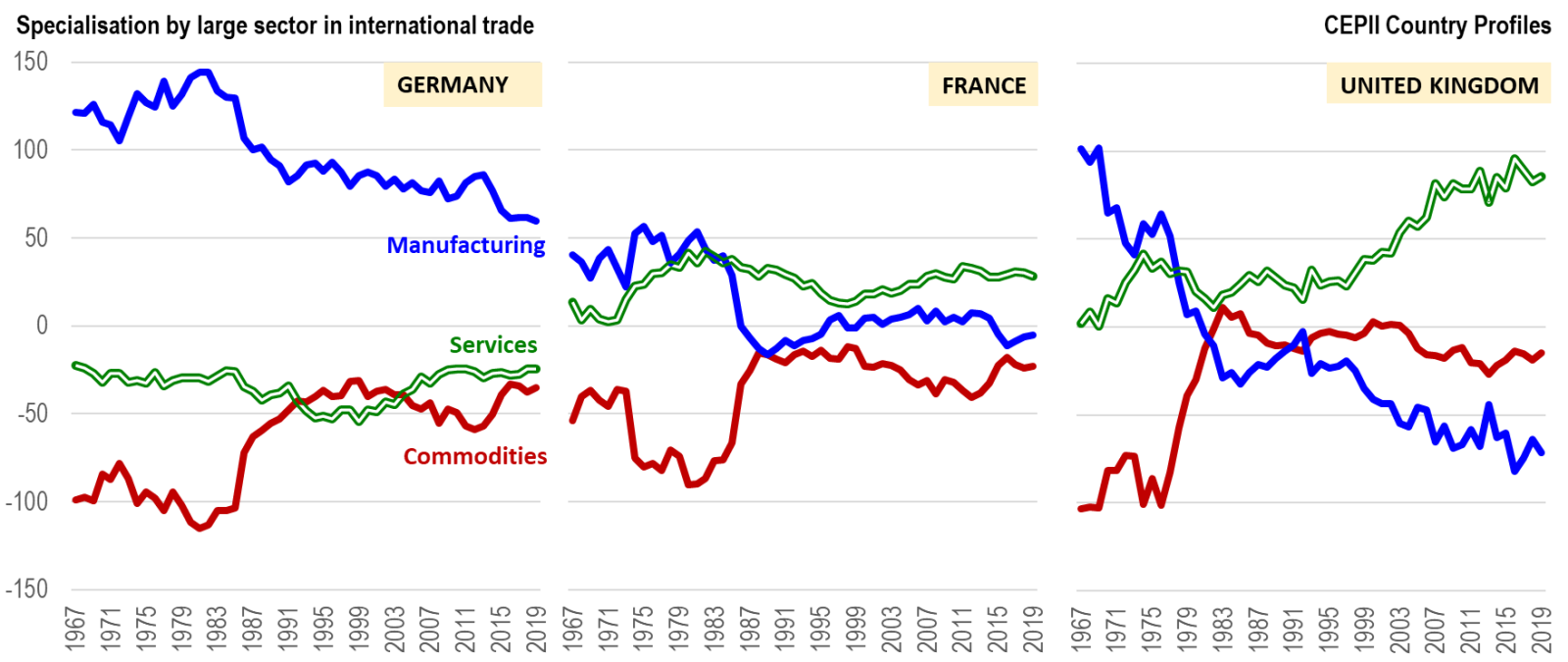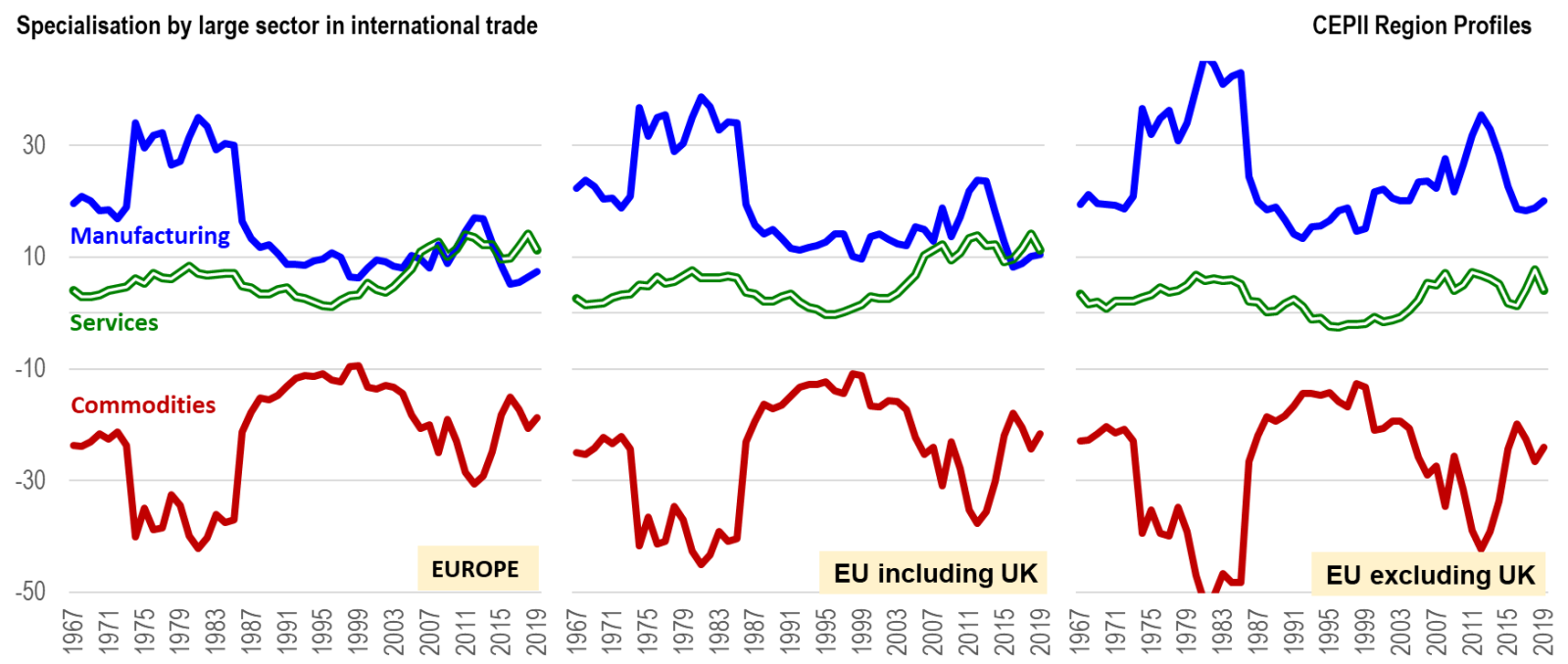The interactive pages Country Profiles based on the CEPII data have just been updated. Open and free of charge, they characterise the international integration of 80 countries in the form of didactic illustrations over seven sections: broad patterns, projections, balance & forex, tariff protection, comparative advantages, types & ranges, products & partners. Thus, the example of comparative advantages over major sectors illustrates the strong commitment of Germany in manufacturing, and of the United Kingdom in services, while the strengths and weaknesses of France are not so acute. These three national patterns reveal one of the major challenges of Brexit for the European Union which is consolidating its comparative advantages in high value-added trade services. The data for the specialisation of the European continent as a whole, as well as that of the EU (with and without the United Kingdom) are now available, among many other indicators in Region Profiles, the new CEPII’s visual data set.
>>> |
As an extension of the Country Profiles, the CEPII has designed the Region Profiles, interactive pages based on its statistical databases. A synthetic analysis tool for globalisation, these visual data allow to characterise the international integration of the 8 major regions making up the world, as well as that of 10 integrated economic areas. The integration patterns can be compared from one region to another, in particular by distinguishing internal exchanges from those carried out with the rest of the world. The data are provided in the form of didactic illustrations over seven categories: broad patterns, projections, balance & forex, tariff protection, comparative advantages, types & ranges, products & partners. The Region Profiles are provided for informational, educational and research purposes, and are freely and publicly available.
>>> |
- CEPII Region Profiles: indicators, databases and classifications
Pierre Cotterlaz, Carl Grekou, Houssein Guimbard, Laurence Nayman & Alix de Saint Vaulry, Gianluca Santoni, Deniz Ünal - CEPII Country Profiles: indicators, databases and classifications
Pierre Cotterlaz, Carl Grekou, Houssein Guimbard, Laurence Nayman & Alix de Saint Vaulry, Gianluca Santoni, Deniz Ünal
China's international economic and financial policies: a quantitative and qualitative perspective
July 1 2021, replay of the webinar
International economic conditions and prospects in the fall of 2021: how are they perceived? With Pew Research Center
September 1 2021, replay of the webinar
20th Doctoral Meetings in International Trade and International Finance
September 16 - 17, 2021
Does the Commodity Super Cycle Matter? Webinar with Andrés Fernández, Head of the Research Department at the Central Bank of Chile
September 23, 2021
Immigration in OECD Countries - 11th Annual International Conference
December 13 - 14, 2021
.PNG) The CEPII, LISER and the OECD as well as their partners from the Fondazione Rodolfo De Benedetti, Paris School of Economics, University of Lille (LEM) and University of Luxembourg are jointly organizing the 11th Annual Conference on "Immigration in OECD Countries" on December 13-14, 2021. The conference will examine the economic aspects of international migration in OECD countries by mapping the migratory flows and analyzing their socio-economic determinants and consequences. Topics of interest include, among others, the determinants of immigration to the OECD, migrants’ self-selection, the political economy of immigration, its labor market and public finance effects, as well as migrants and refugees social, political and economic integration. The CEPII, LISER and the OECD as well as their partners from the Fondazione Rodolfo De Benedetti, Paris School of Economics, University of Lille (LEM) and University of Luxembourg are jointly organizing the 11th Annual Conference on "Immigration in OECD Countries" on December 13-14, 2021. The conference will examine the economic aspects of international migration in OECD countries by mapping the migratory flows and analyzing their socio-economic determinants and consequences. Topics of interest include, among others, the determinants of immigration to the OECD, migrants’ self-selection, the political economy of immigration, its labor market and public finance effects, as well as migrants and refugees social, political and economic integration.25 September 2021: deadline for submitting papers >>> |
 With Rebecca Ray, Senior Academic Researcher, Boston University Global Development Policy Center With Rebecca Ray, Senior Academic Researcher, Boston University Global Development Policy Center>>> |
.jpg) With Shannon Schumacher, Research associate, Pew Research Center, Dr. Richard Wike, Director, global attitudes research , Pew Research Center, and Sébastien Jean, Director, CEPII With Shannon Schumacher, Research associate, Pew Research Center, Dr. Richard Wike, Director, global attitudes research , Pew Research Center, and Sébastien Jean, Director, CEPII>>> |
- Contact us
- Our other sites
 |
ISSN: 1255-7072
Editorial Director : Antoine BouëtManaging Editor : Evgenia Korotkova












